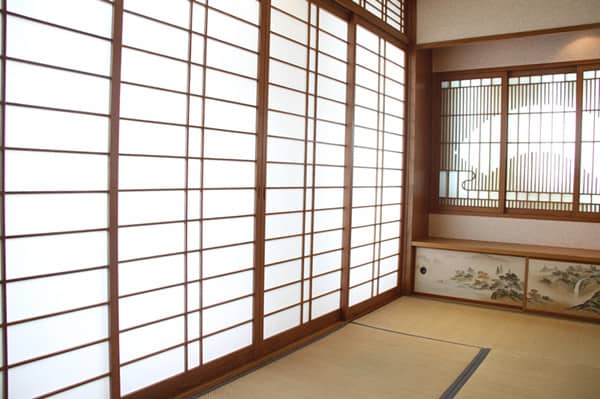In traditional Japanese architecture, a shoji is a door, window or room divider consisting of translucent paper over a frame of wood which holds together a lattice of wood or bamboo. While washi is the traditional paper, shoji is made of paper made by modern manufacturing processes, plastic is also in use.
Another type of sliding door or partition are shoji, which are made up of wooden lattices covered in translucent paper. Shoji are typically found along the perimeter of the building, allowing light to filter in. Some shoji doors incorporate sliding panels that move up and down like small windows to allow more light or air to enter the room. Occasionally shoji may have a sheet of glass covering one side of the door.
◊ Material
Paper pulp, fiber, hemp, nylon
◊ Function
Shoji paper is used in traditional houses as well as Western-style housing, especially in the washitsu(Japanese-style room). In modern construction, the shoji does not form the exterior surface of the building, it sits inside a sliding glass door or window.

◎ Waterproof
◎ Strong
◎ Air permeability
◎ Humidity control
◎ Non flame retardance
◊ How to choose shoji paper
► Traffic/Location: More traffic by the screen, more durable you’ll need.
► Moisture/Outdoor Use: Regular shoji paper is not supposed to get wet.
► Installation/Maintenance: Shoji paper is durable and maintenance-free just for years.
► Thickness: Shoji paper is quite thicker than regular copy paper.
► Transparency: Shoji paper blocks the view, but not the light.
► Color: Common shoji paper is often bright white, which is the most popular in Japan.
► Size: Our shoji paper comes in at least 92cm wide and 50m long per roll.
◊ How to attach shoji paper using double sided tape

1. Lay the screen on a table. If the screen has an inside ledge for the paper to sit in, cut shoji paper a little shorter (1/32″-1/16″) within the ledge so that there is a room to expand for the paper.

2. Apply double sided tape on the bottom rail, and all the vertical frames and vertical lattices. Do not peel off the backings yet.

3. Lay shoji paper on the screen and position it. Use a few pieces of masking tape to keep the paper in place if necessary. Peel off the backing only from the bottom rail. Press the paper lightly on the tape. Keep the paper rolled up at the bottom.

4. Peel off the backing on all the tapes from vertical frames and lattices. After that, apply double sided tape on all the horizontal lattices and the top frame.

5. Peel off all the backings from horizontal pieces.

6. Slowly unroll the paper while smoothing out from the center towards outer edges. Press on taped parts using hands or a roller.

